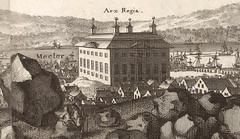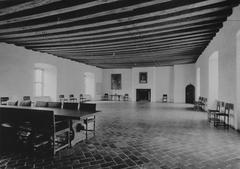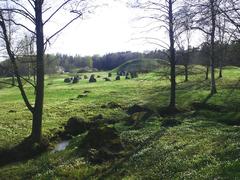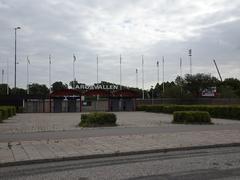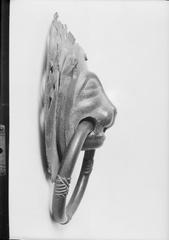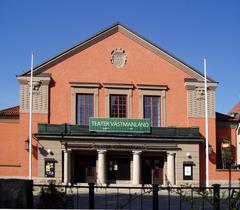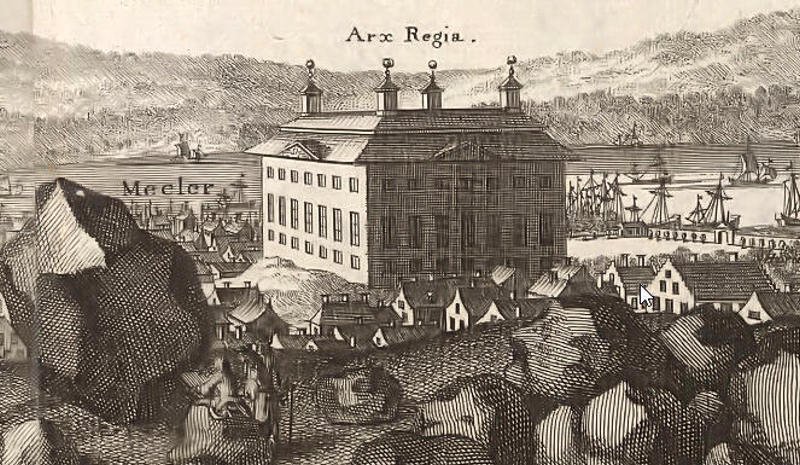
Västerås Castle: Visiting Hours, Tickets, and Historical Sites Guide
Date: 14/06/2025
Introduction to Västerås Castle
Västerås Castle (Västerås slott), situated in the heart of Västerås, Sweden, stands as a monumental symbol of the nation’s historical, architectural, and cultural evolution. With origins tracing back to the late 13th century, the castle has played a pivotal role in Sweden’s political and religious transformations. Its enduring presence—from medieval fortress to Renaissance palace and Baroque residence—mirrors centuries of adaptation, restoration, and community engagement. Today, Västerås Castle is not only a historical landmark but also a lively cultural hub, offering exhibitions, events, and access to some of Sweden’s most iconic sites.
This guide provides a comprehensive overview of Västerås Castle’s history, architectural highlights, visitor information, accessibility, and nearby attractions. Whether you are a history enthusiast, cultural explorer, or a casual traveler, you’ll find essential tips and recommendations to plan an unforgettable visit. For the latest updates, always refer to the Visit Sweden and Västerås tourism websites.
Table of Contents
- Early Foundations and Medieval Significance
- Renaissance Rebuilding and Royal Events
- Baroque and Later Architectural Evolution
- Artistic Heritage and Exhibitions
- Gardens and Natural Surroundings
- Cultural and Community Role
- Visiting Hours and Ticket Information
- Accessibility
- Guided Tours and Events
- On-site Amenities
- Getting There and Transport
- Best Time to Visit
- Nearby Attractions and Itineraries
- Visitor Tips and FAQs
- Conclusion and Further Resources
Early Foundations and Medieval Significance
The earliest fortifications of Västerås Castle date back to the late 1200s, a period when Västerås grew in importance as a religious and administrative center. Strategically located near Lake Mälaren, the castle’s original purpose was to control vital trade routes and protect the burgeoning town. Its close proximity to Västerås Cathedral, one of Sweden’s oldest churches, enhanced its status as both a secular and ecclesiastical stronghold. During the Middle Ages, the castle served as a royal residence and administrative hub, particularly during times of political unrest or consolidation of power (Visit Sweden).
Renaissance Rebuilding and Royal Events
The 16th century saw major transformations under King Gustav Vasa, who expanded and modernized the castle with Renaissance features. Notably, the 1527 Riksdag of Västerås was convened within its walls, leading to the historic adoption of Lutheranism as Sweden’s state religion—a turning point known as the Swedish Reformation. Successive monarchs continued to use the castle for royal gatherings, significant assemblies, and administrative functions (Visit Sweden).
Baroque and Later Architectural Evolution
In the 17th and 18th centuries, the castle underwent further renovations, adopting Baroque stylistic elements such as grand facades, ornate window treatments, and formal gardens. Its imposing towers, whitewashed walls, and harmonious symmetry epitomize the blend of Renaissance solidity and Baroque elegance (Tourist Places Guide; Wanderlog). Over the centuries, restoration projects have preserved the castle’s historical features while enabling contemporary cultural uses.
Artistic Heritage and Exhibitions
Select areas of Västerås Castle are open to the public during guided tours and special events. Visitors encounter grand halls adorned with intricate woodwork, decorative plasterwork, and period chandeliers. The castle boasts collections of royal portraits, antique weaponry, ceremonial regalia, and rotating art exhibitions, reflecting its long-standing role as a seat of power and culture (Tourist Places Guide).
The Västmanland County Museum, housed within the castle, showcases the region’s heritage through artifacts, archival materials, and interactive exhibits (Exit45Travels). Temporary exhibitions and cultural events are held regularly, so check the latest program before your visit.
Gardens and Natural Surroundings
The castle’s Baroque gardens feature symmetrical layouts, manicured lawns, and ornamental flowerbeds, offering a picturesque setting for walks, photography, and outdoor events (Tourist Places Guide). Its location by Lake Mälaren provides breathtaking vistas and a tranquil ambiance, enhancing the overall visitor experience (Wanderlog).
Cultural and Community Role
Today, Västerås Castle is a vibrant center for cultural life. It hosts concerts, performances, art exhibitions, lectures, workshops, weddings, and community celebrations—including Midsommar festivities with Swedish music and dance (ArrivalGuides). The castle’s ongoing engagement with the public ensures its continued relevance as a gathering place and living institution.
Visiting Hours and Ticket Information
- April to September: Tuesday to Sunday, 10:00 AM – 6:00 PM
- October to March: Wednesday to Sunday, 11:00 AM – 4:00 PM
- Closed on Mondays and major public holidays
Admission Fees:
- Adults: 100 SEK
- Students/Seniors: 70 SEK
- Children under 18: Free
- Family and group tickets available
Tickets can be purchased online via the official Västerås tourism website or at the castle entrance. Sweden is largely cashless, so credit/debit cards are preferred.
Note: Hours and prices may vary for special events or exhibitions. Always consult the official website for current information.
Accessibility
Västerås Castle is committed to providing access for all visitors:
- Ramps and elevators are available for wheelchair users and those with mobility challenges.
- Accessible restrooms are provided.
- Service animals are welcome.
- Staff are available to assist and provide information in multiple languages.
Due to the castle’s historic structure, some upper floors may be inaccessible; contact staff in advance for specific accommodations.
Guided Tours and Events
- Guided Tours: Offered in Swedish and English, lasting 45–60 minutes. Highlights include architectural evolution, royal history, and key political events, such as the imprisonment of King Eric XIV (SpottingHistory).
- Booking: Advance booking is recommended, especially for groups or during high season.
- Cultural Events: The castle hosts art exhibitions, concerts, and seasonal festivals throughout the year (Tourist Places Guide; Thatsup). An updated event calendar is available on the Västerås events page.
On-site Amenities
- Café and Restaurant: Enjoy Swedish fika, lunch specials, and vegetarian options with views of the gardens (Routes North).
- Gift Shop: Offers locally crafted souvenirs, books, and products inspired by the region and castle history (Exit45Travels).
- Restrooms and Cloakroom: Modern facilities, including accessible restrooms and lockers for your convenience.
Getting There and Transport
- By Train: Västerås Central Station is a 10–15 minute walk from the castle, with direct connections to Stockholm and regional cities (WildTrips; Routes North).
- By Car: The city is accessible via the E18 motorway; public parking is available near Aros Congress Center and Central Station.
- By Foot/Bike: The city’s compact layout allows for easy walking or cycling to the castle and nearby attractions.
Best Time to Visit
Late spring to early autumn (May–August) offers the most pleasant weather, vibrant gardens, and a full calendar of events. Winter provides a quieter experience and atmospheric interiors, though with reduced hours.
Nearby Attractions and Suggested Itineraries
- Västerås Cathedral: A 13th-century Gothic masterpiece, just a short walk from the castle.
- Anundshög Burial Mound: The largest Viking burial mound in Sweden, ideal for history enthusiasts.
- Vallby Open Air Museum: Showcasing regional heritage through historic buildings and exhibits.
- Lake Mälaren: Scenic walks, boating, and picnicking along the waterfront.
Combine these sites for a full day or weekend itinerary centered around Västerås Castle (TouristPlaces.Guide).
Visitor Tips and Frequently Asked Questions (FAQ)
Q: What are Västerås Castle’s visiting hours?
A: Typically Tuesday to Sunday, 10:00–18:00 (April–September), and Wednesday to Sunday, 11:00–16:00 (October–March). Check the official website for updates.
Q: Are guided tours available and included in admission?
A: Yes, tours are offered in English and Swedish and are often included; advance booking may be required.
Q: Is the castle accessible for wheelchair users?
A: Yes, with ramps, elevators, and accessible restrooms, though some historic areas may remain inaccessible.
Q: Can I take photos inside the castle?
A: Non-flash photography is permitted in most areas; restrictions apply during certain exhibitions.
Q: Are pets allowed?
A: Only service animals are permitted inside the castle.
Q: How long should I plan for a visit?
A: Allocate 1.5–2 hours to explore the castle, exhibitions, and gardens.
Conclusion
Västerås Castle is a vibrant testament to Sweden’s royal legacy, architectural artistry, and community spirit. Its layered history, stunning gardens, and dynamic cultural calendar make it a must-visit for travelers seeking both historical depth and contemporary experiences. Plan your visit by checking the latest opening hours, securing tickets online, and exploring nearby attractions for a comprehensive journey through Swedish heritage.
Stay updated on events and exhibitions by following Västerås Castle on social media and consider downloading the Audiala app for interactive audio guides and personalized travel tips.
Sources and Further Reading
- Västerås Castle: Visiting Hours, Tickets, History, and Things to Do in Västerås, Visit Sweden
- Västerås Castle Visiting Hours, Tickets, and Historical Significance: A Complete Guide, Tourist Places Guide
- Västerås Castle Visiting Hours, Tickets & Visitor Guide: Explore a Historic Swedish Landmark, Wanderlog
- Practical Visitor Information, Visit Västerås
- WildTrips: Places to Visit in Västerås
- Routes North: What to See and Do in Västerås
- Exit45Travels: Things to Do in Västerås
- SpottingHistory: Västerås Castle
- ArrivalGuides: Västerås Castle
- Thatsup: The Guide to Västerås
